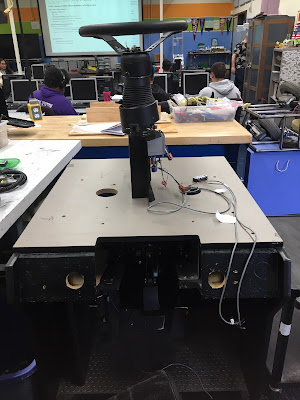https://www.instructables.com/id/Guino-Dashboard-for-your-Arduino/
https://github.com/speeddragon/Arduino-CarSensorDashboard/blob/master/car_sensor_dashboard/car_sensor_dashboard.ino
https://www.ebay.com/itm/Race-Car-Ignition-Switch-Panel-Engine-Start-Toggle-Push-Button-DC-12V-Universal/283505723211?hash=item420242074b:g:UrwAAOSwXFlc9g3B
Thursday, February 6, 2020
Sunday, February 2, 2020
Saul Payan-FPD- Update
 |
| Front of First Person Driver, with steering wheel column and dashboard taken off. |
 |
| Starting the process of building all the electrical connections. |
 |
| Screw down terminals being used to group ground and power of outputs together. Common signal wires left individually. |
 |
| Example of procedure explained above. |
Saul Payan - FPD - LED Circuit Lab
 |
| Linear potentiometer |
Saul Payan - FPD - Data Sheet# 1
DATA SHEET
Presented here is the Data Sheet (graph) of the:
LED Circuit Board, located in the back of the car dashboard of the First Person Driver(FPD).
The goal of this Data sheet is to leave the reader feeling confident in their ability to distinguish between the 17 different LED output wires and their purpose, know all the inputs located in First Person Driver itself, and have a general idea of how the electronics system works.
In graph #1, we explain which LED "D" Number (Ex. D-14, D-7, D-15) connects to what pins on the board, along with;
~ Wire Color Scheme ( first-most color being the "main", with a single-stripe secondary color)
~ LED-Color Output
* There are 20 Male-pins present on-board, only *15 are used as outputs (15 LED's on-board).
Of which, 15 wires ( D-1 through D-15) stem from the Female connector, connecting to the Male pins (1 through 20) on-board. D-19- and D-20 are used as Ground and Power. Each of the wires, D-1 through D-15, can act as a ground, creating a closed circuit, when connected to D-20.
Subsequently, there will be 2 additional graphs, that;
~ assign a function to each of the 15 LED Outputs.
~ show the 10 (different) Inputs I will be using, and how each of them turns on one specific LED Output,
along with the 4 Unused LED outputs I plan to change the function of.
(Note- Number of outputs may change in the future. Some inputs have multiple outputs, along with no outputs at all,which will be shown in graph #3).
We will also explain how we plan to use the Speedometer and Tachometer as additional (Non-LED) outputs (12 Outputs).
*(Directly underneath, I have provided a diagram of reference, so the reader can acknowledge the 1-20 pins (located on the Circuit board) being discussed).
> Pins (Male, located on-board)
| 1 | 2 |
| 3 | 4
| 5 | 6
| 7 | 8 |
| 9 |10|
11|12|
|13|14|
|15|16
|17|18
|19|20|
GRAPH #1
LED PINS: Wire Color: LED Color:
D-1 = Pin 1 Purple (P) RED
D-2 = Pin 2 Yellow/ Red (Y/R) RED
D-3 = Pin 3 Yellow/Green (Y/G) RED
D-4 = Pin 4 Black/Yellow (B/Y) RED
D-5 = Pin 5 Yellow/Orange (Y/O) RED
D-6 = Pin 6 Yellow/White (Y/W) RED
D-7 = Pin 10 White/Brown (W/B) RED
D-8 = Pin 11 Grey (G) RED
D-9 = Pin 12 White/Purple (W/P) RED
D-10 = Pin 13 Yellow/Purple (Y/P) BLUE
D-11 = Pin 14 White (W) RED
D-12 = Pin 15 Grey/Black (G/B) ORANGE
D-13 = Pin 7 Yellow/Grey (Y/G) RED
D-14 = Pin 8 White/Blue (W/B) Green
D-15 = Pin 9 White/ Green (W/G) Green (
----------------------------------------------------------------------------------------------------------------------------------D-19 = Pin 19 Yellow (Y) N/A (Ground)
D-20 = pin 20 Yellow (Y) N/A (Power)
GRAPH #2
LED Output: Function:
D-1 "1"
D-2 "2"
D-3 "3"
D-4 "D"
D-5 "N"
D-6 "R"
D-7 "Oil Pressure"
D-8 "Brake System Alert"
D-9 "Seat Belt"
D-10 "High Beam Light"
D-11 "Temperature"
D-12 "ABS" (Anti-Lock Breaking System)
D-13 "p"
D-14 "Left Blinker"
D-15 "Right Blinker"
Graph #3
Inputs(10): Outputs(12)
1.) Gas N/A
2.) Break N/A
3.) Steering Wheel N/A
4.) Speaker N/A
5.) E-Brake N/A
6.) Gear Shift ⇨ (1, 2, 3) (P, R, N, D)
(D-1, D-2, D-3) (D-13, D-6, D-5, D-4)
7.) Horn N/A
8.) Turn Signals ⇨ (Left/Right Blinker)
(D-14,D-15)
9.) Seat Belt ⇨ (Seat Belt)
(D-9)
10.) Anti-Lock ⇨ (D-12)
N/A Speedometer
N/A Tachometer
----------------------------------------------------------------------------------------------------------------------------------
Unused Outputs:
Oil Pressure (D-7)
Temperature (D-11)
High Beam Light (D-10)
Brake System Alert (D-8)
The speedometer and Tachometer are additional outputs displayed on the car dashboard. They will receive a signal from an Arduino,which will transmit input from the potentiometer located on the Gas and Break pedals. When powered, we will measure the resistance of the potentiometers and see the difference when they are and aren't fully pressed down. This will allow us to come up with a ratio of MPH that can be sent as a signal to the Tachometer and Speedometer.
Subscribe to:
Comments (Atom)


